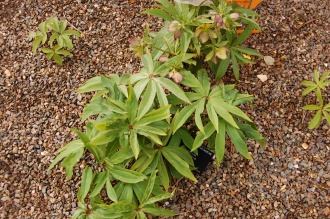Position: Full sun to dappled shade
Flowering period: Late winter early spring
Soil: Moist, well drained
Eventual Height: 45cm
Eventual Spread: 45cm
Hardiness: 5a, 5b, 6a, 6b, 7a, 7b, 8a, 8b, 9a, 9b
Family: Ranunculaceae
Helleborus atrorubens is a deciduous herbaceous perennial with a variable habit. Its dark green leaves are circular, deeply palmately divided with five leaflets. Its leaflets are elliptic with serrulate margins. Its green/ bronze/ red flowers are pendent, cup shaped, produced on upright stems and up to 5cm across.
Helleborus atrorubens, commonly known as Red Hellebore, is native to the Balkans.
The etymological root of the binomial name Helleborus is from the classical name for Helleborus niger. Atrorubens is derived from the Latin ater meaning ‘dark coloured’ and rubra meaning ‘red’.
The landscape architect may find Helleborus atrorubens useful as an attractive early flowering herbaceous perennial suitable for planting in woodland settings and shady locations. Care should be taken when locating this plant as all parts are poisonous.
Ecologically, Helleborus atrorubens flowers are attractive to pollinating insects.
Helleborus atrorubens prefers moist, deep, humus rich, fertile, well-drained soils. It tolerates most pH of soil, although it prefers lime soils.
Helleborus atrorubens requires little maintenance.







Leave a comment